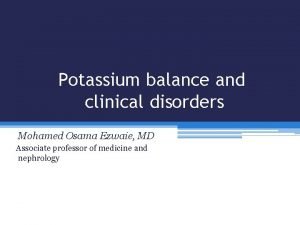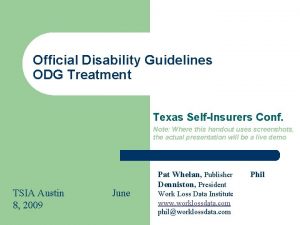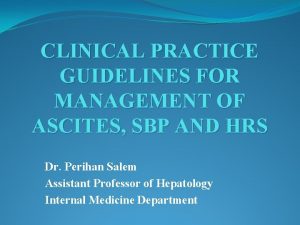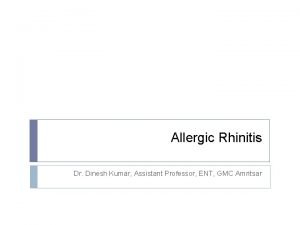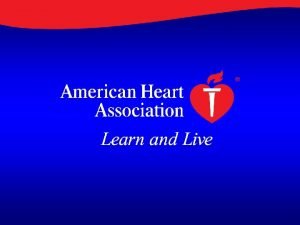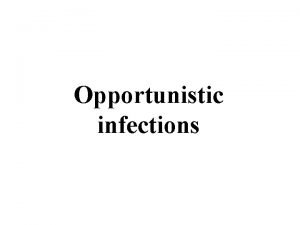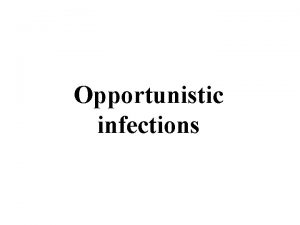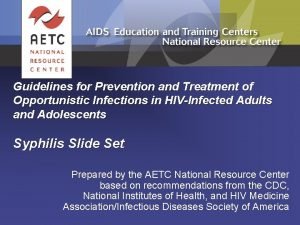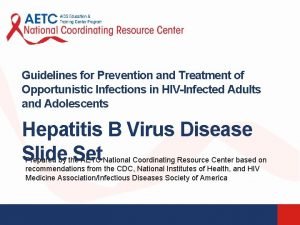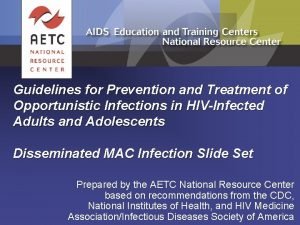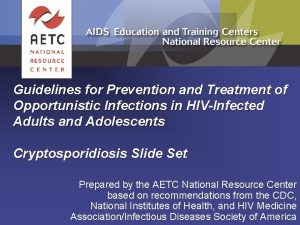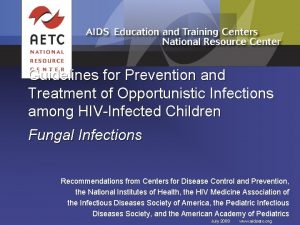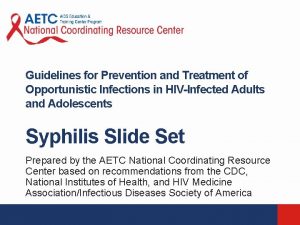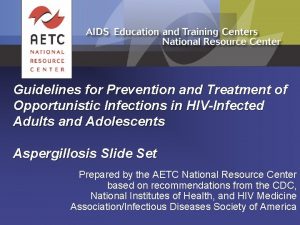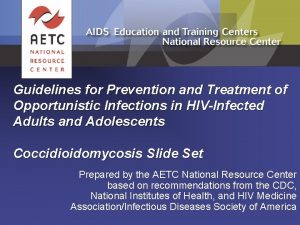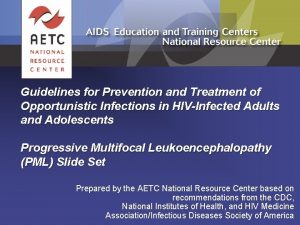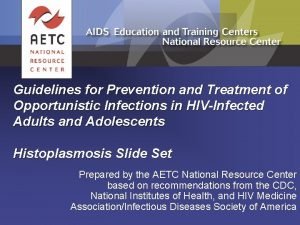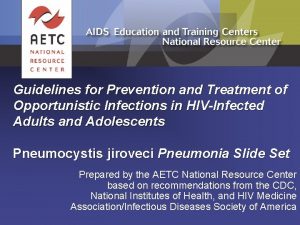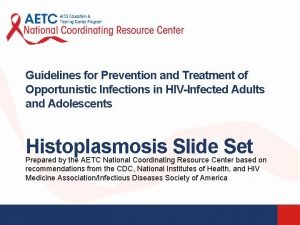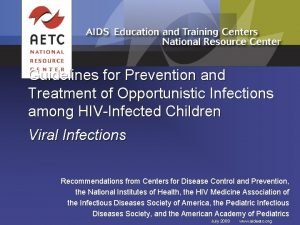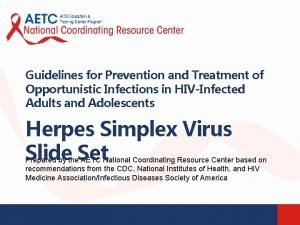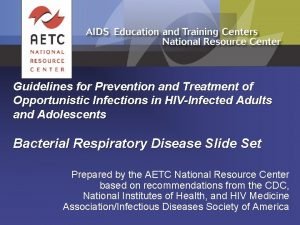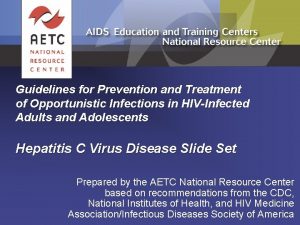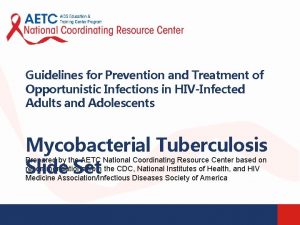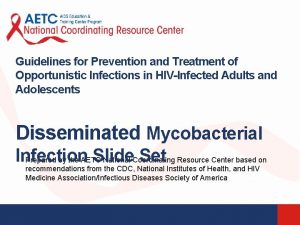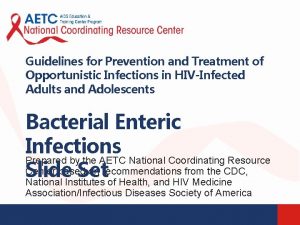Guidelines for Prevention and Treatment of Opportunistic Infections













































- Slides: 45

Guidelines for Prevention and Treatment of Opportunistic Infections in HIV-Infected Adults and Adolescents Human Papillomavirus Slide Set Prepared by the AETC National Resource Center based on recommendations from the CDC, National Institutes of Health, and HIV Medicine Association/Infectious Diseases Society of America

About This Presentation These slides were developed using recommendations published in May 2013. The intended audience is clinicians involved in the care of patients with HIV. Users are cautioned that, because of the rapidly changing field of HIV care, this information could become out of date quickly. Finally, it is intended that these slides be used as prepared, without changes in either content or attribution. Users are asked to honor this intent. – AETC National Resource Center http: //www. aidsetc. org 2 May 2013 www. aidsetc. org

HPV Disease: Epidemiology § HPV causes spectrum of anogenital disease, from warts and condyloma acuminata to squamous cell cancer § HPV is the main cause of cervical cancer, also most anal cancer and some tumors of vulva, vagina, penis, oral cavity, and oropharynx § Most HPV infections resolve or become latent and undetectable § Tumorigenesis requires persistent infection with oncogenic HPV type § Transmitted by sexual contact 3 May 2013 www. aidsetc. org

HPV Disease: Epidemiology (2) § Oncogenic HPV types: 16, 18, 31, 35, at least 8 others § Type 16 accounts for ~50% of cervical cancers and most noncervical cancers in the general population; HPV 18 accounts for 10 -15% of cervical cancers § Types 6 and 11 associated with 90% of genital warts 4 May 2013 www. aidsetc. org

HPV Disease: Epidemiology (3) Cervical dysplasia and cancer: § In women with HIV infection § Higher rates of cervical cancer § Higher rates of: § HPV infection § Oncogenic HPV types § Cervical intraepithelial neoplasia (CIN) (low grade and high grade) § Increased risk with lower CD 4 cell counts § Vulvar and vaginal intraepithelial neoplasia also more common 5 May 2013 www. aidsetc. org

HPV Disease: Epidemiology (4) Anal dysplasia and cancer: § In women and men with HIV infection § Higher incidence of anal cancer § Higher rates of anal intraepithelial neoplasia (AIN) § Higher risk of anal cancer with lower CD 4 counts 6 May 2013 www. aidsetc. org

HPV Disease: Epidemiology (5) Genital and anal warts: § Incidence and prevalence are higher in HIV-infected patients 7 May 2013 www. aidsetc. org

HPV Disease: Epidemiology (6) § Impact of ART on incidence of HPV-associated cancers is not clear; may differ by tumor type § Limited evidence that ART may decrease progression of CIN § No overall change in incidence of cervical cancer since introduction of ART, and anal cancer rates are increasing § Incidence of low-grade VIN lesions and anogenital warts lower with ART, though rate of high-grade VIN unchanged § Conflicting data re impact of ART on oral warts – some, but not all, studies report increased rates after ART initiation 8 May 2013 www. aidsetc. org

HPV Disease: Epidemiology (7) § HPV vaccine: § Use in adolescents and young adults may reduce risk of cancers caused by HPB 16 and 18 in HIV-infected people later in life 9 May 2013 www. aidsetc. org

HPV Disease: Clinical Manifestations and Diagnosis Warts: genital, and oral § Usually flat, papular, or pedunculated growths on mucosa or epithelium, 2 mm to 2 cm, may occur in clusters § Often asymptomatic; may cause itching or discomfort § Diagnosis: visual inspection; biopsy if uncertain diagnosis § HPV DNA: no data support use for Condyloma acuminata, perianal routine diagnosis or management Credit: P. Volberding, MD; UCSF Center for HIV Information Image Library 10 May 2013 www. aidsetc. org

HPV Disease: Clinical Manifestations and Diagnosis (2) Cervical and vaginal intraepithelial neoplasia (CIN, VIN) and squamous cell cancers § No characteristic symptoms; often asymptomatic, may present with bleeding or mass § Screening: § Visual inspection of entire anogenital area § Pap test § Cytology (Pap) and colposcopy techniques as in HIVuninfected women § Digital examination of vaginal, vulvar, perianal regions, and anal canal to feel for masses § High-resolution colposcopy and biopsy as needed 11 May 2013 www. aidsetc. org

HPV Disease: Clinical Manifestations and Diagnosis (3) Anal, vulvar, and vaginal intraepithelial neoplasia; oral HPV disease § No characteristic symptoms; often asymptomatic, may present with bleeding or itching; external lesions may be visible or palpable § Screening: § § § 12 Visual inspection Anal cytology Digital examination to feel for masses High resolution anoscopy as needed Biopsy of suspicious lesions May 2013 www. aidsetc. org

HPV Disease: Clinical Manifestations and Diagnosis (4) Role of HPV testing § Role of cervical HPV testing for HIV-infected women has not been established § Some specialists recommend HPV testing for triage of women with ASC-US, as in HIV-uninfected women § Utility uncertain, given high prevalence of oncogenic HPV in HIV-infected women § Anal and other noncervical specimens: no recommendation § Prior to HPV vaccination: no recommendation 13 May 2013 www. aidsetc. org

HPV Disease: Preventing Infection Vaccination § HPV vaccines (quadrivalent and bivalent), prevent HPV 16 and 18 cervical, vaginal, and vulvar infections, precancers, and cancers in females § Quadrivalent vaccine also prevents § HPV 16 and 18 anal infections and precancers § HPV 6 and 11 infections § No efficacy data in HIV-infected individuals (studies ongoing), though quadrivalent vaccine shown to be safe and immunogenic 14 May 2013 www. aidsetc. org

HPV Disease: Preventing Infection (2) § HPV vaccine (bivalent or quadrivalent) is strongly recommended for HIV-infected girls aged 9 -12 years § Also recommended for HIV-infected females aged 13 -26 years § Quadrivalent vaccine is strongly recommended for HIV-infected boys aged 9 -12 years § Also recommended for HIV-infected males aged 13 -26 years 15 May 2013 www. aidsetc. org

HPV Disease: Preventing Infection (3) § Vaccination ideally should precede sexual exposure to HPV; likely to be less effective in persons aged 19 -26 because they already may have acquired HBV 6, 11, 16, or 18 § Data insufficient to recommend vaccination for those aged >26; HPV vaccines not approved for age >26 § HIV-infected women who have been vaccinated should have routine cervical cancer screening 16 May 2013 www. aidsetc. org

HPV Disease: Preventing Infection (4) Condom use § Use of male latex condoms is strongly recommended for preventing transmission or acquisition of HPV § Associated with lower rates of HPV infection § If male condoms cannot be used properly, a female condom should be considered 17 May 2013 www. aidsetc. org

HPV Disease: Preventing Infection (5) Male circumcision § Lower rates of oncogenic HPV infection of the penis § In the general population, lower risk of penile cancer and of cervical cancer in sex partners (data from observational studies) § In HIV-infected men, limited data suggest effect is protective but to lesser degree § Effect on genital, anal, or oral HPV-related cancer or precancer in HIV-infected men or their sex partners not known § In the U. S. , insufficient evidence to recommend adult male circumcision for the purpose of reducing risk of oncogenic HPV infection 18 May 2013 www. aidsetc. org

HPV Disease: Preventing Disease – Cervical Cancer § For all HIV-infected women who have initiated sexual activity: screening Pap at 6 -month intervals in first year after HIV diagnosis; annually thereafter if results are normal § Consider screening within 1 year of sexual activity, regardless of age or mode of HIV infection § High rate of progression of abnormal cytology in HIVinfected adolescents and young women who were infected via sex; high rate of cervical abnormalities in perinatally infected adolescents § Annual screening should continue for life: HIV-infected women remain at risk of development of cervical cancer 19 May 2013 www. aidsetc. org

HPV Disease: Preventing Disease – Cervical Cancer (2) § If abnormal Pap result, care generally should be provided according to American Society for Colposcopy and Cervical Pathology (ASCCP) guidelines § Exception: in HIV-infected women, HPV testing alone is not recommended for follow-up of an abnormal Pap test 20 May 2013 www. aidsetc. org

HPV Disease: Preventing Disease – Cervical Cancer (3) Management of abnormal results § ASC-US § Immediate referral for colposcopy or repeat cytology in 6 -12 months § Greater than ASC-US (ASC-H, LSIL, or HSIL) § Refer for colposcopy 21 May 2013 www. aidsetc. org

HPV Disease: Preventing Disease – Vaginal and Vulvar Cancer § Women with history of high-grade CIN or cervical cancer: regular vaginal cuff Pap test § Routine screening not recommended after hysterectomy for benign disease in absence of prior CIN 2 -3 or cancer § Abnormal vaginal Pap results: vaginal colposcopy with Lugol iodine solution § Concomitant cervical and vulvar lesions: vaginal colposcopy § No available screening procedure for vulvar cancer; biopsy or refer if suspected lesions 22 May 2013 www. aidsetc. org

HPV Disease: Preventing Disease – Anal Cancer § No national recommendations for routine screening; some specialists recommend anal cytologic screening of all HIV-infected men and women: § Annual digital rectal exam for masses § Management of abnormal anal Pap results § ASC-US, ASC-H, LSIL, or HSIL: high-resolution anoscopy § Biopsy of visible lesions 23 May 2013 www. aidsetc. org

HPV Disease: Treatment – Genital and Oral Warts § In HIV infection, warts may be larger or more numerous, may not respond well to therapy, and may recur more frequently § No uniformly effective or preferred § For intra-anal, vaginal, or cervical warts, refer to a specialist 24 May 2013 www. aidsetc. org

HPV Disease: Treatment – Genital and Oral Warts (2) § Patient-applied treatment § For uncomplicated external warts § Podophyllotoxin (e. g. , podofilox 0. 5% solution or 0. 5% gel) applied to lesions BID for 3 days, followed by 4 days of no therapy, repeated weekly for up to 4 weeks § Imiquimod 5% cream applied to lesions at bedtime and washed off in morning, 3 nonconsecutive nights per week for up to 16 weeks § Sinecatechins 15% ointment applied to area TID for up to 16 weeks 25 May 2013 www. aidsetc. org

HPV Disease: Treatment – Genital and Oral Warts (3) § Provider-applied treatment § For complex or multicentric lesions, or lesions inaccessible to patient § Cryotherapy (liquid nitrogen or cryoprobe), repeat every 1 -2 weeks for up to 4 weeks § Trichloroacetic or bichloroacetic acid 80 -90% aqueous solution to lesions, repeat weekly for up to 6 weeks 26 May 2013 www. aidsetc. org

HPV Disease: Treatment – Genital and Oral Warts (4) § Provider-applied treatment (cont’d) § Surgical excision or laser surgery § Podophyllin resin 10 -25% in tincture of benzoin; weekly for up to 6 weeks § Other treatments: consider if above are not effective: § Topical cidofovir (not available commercially) § Intralesional interferon not recommended § Oral warts: surgical treatment is most common; many topicals cannot be used on oral mucosa 27 May 2013 www. aidsetc. org

HPV Disease: Treatment – CIN and Cervical Cancer § Manage with a specialist § Follow ASCCP guidelines, in general 28 May 2013 www. aidsetc. org

HPV Disease: Treatment – CIN and Cervical Cancer (2) § High-grade CIN: § Satisfactory colposcopy: ablation or excision § Unsatisfactory colposcopy: excision § Recurrent high-grade CIN: diagnostic excisional methods; hysterectomy is acceptable § Invasive cervical, vaginal, vulvar cancer § Follow National Comprehensive Cancer Network guidelines § Standard treatment appears safe and effective § Complication and failure rates may be higher in HIVinfected women 29 May 2013 www. aidsetc. org

HPV Disease: Treatment – CIN and Cervical Cancer (3) § HIV-infected adolescents § Follow ASCCP guidelines for adolescents and young women § Progression and recurrence of lesions is more common § For CIN 1 and CIN 2, consider close observation (per guidelines recommendations) § If compliance is questionable, may be preferable to follow the treatment arm of management for CIN 2 30 May 2013 www. aidsetc. org

HPV Disease: Treatment – VIN, VAIN, Vulvar and Vaginal Cancers § Consult with specialists; individualize care § Low-grade VIN/VAIN: can observe or manage as for vulvovaginal warts § VIN: local excision, laser vaporization, ablation, imiquimod § VAIN: topical 5 -fluorouracil (5 -FU), laser vaporization, excision § Vulvar and vaginal cancer: individualize care, follow National Comprehensive Cancer Network guidelines 31 May 2013 www. aidsetc. org

HPV Disease: Treatment – AIN and Anal Cancer § Insufficient data to recommend specific treatment approaches § Choice of treatment based on size and location of lesion, histologic grade § Options for AIN: § Infrared coagulation has moderate efficacy for AIN 2 or 3 in HIV-infected patients § Others: topical 5 -FU, cryotherapy, laser therapy, surgical excision § Local TCA has been used for AIN; intra-anal imiquimod shows moderate efficacy for intra-anal AIN § Anal cancer: consult with specialist; combination radiation and chemotherapy used most commonly 32 May 2013 www. aidsetc. org

HPV Disease: Treatment – Other HPVAssociated Cancers § HPV-associated penile and oropharyngeal cancers: as in HIV-uninfected patients § Prognosis may be better with HPV-associated oropharyngeal cancers than with non-HPVassociated 33 May 2013 www. aidsetc. org

HPV Disease: Starting ART § To date, no data show that ART initiation should be influenced by presence of HPV-related disease § Some studies found decreased persistence and progression of CIN during ART, but no change in incidence of cervical cancer, and anal cancer incidence has increased § No data show that treatment for CIN or AIN should be modified for patients on ART or that ART should be started or modified for treatment of CIN or AIN 34 May 2013 www. aidsetc. org

HPV Disease: Monitoring and Adverse Events § Increased risk of recurrence of CIN and cervical cancer in HIV-infected patients § Frequent cytologic screening and colposcopy according to guidelines § No IRIS has been described in association with HPV infections 35 May 2013 www. aidsetc. org

HPV Disease: Monitoring and Adverse Events (2) § All treatment modalities have risk of adverse effects: monitor by physical exam and symptom review during and after treatment § Ablative and excisional modalities: pain, discomfort, intraoperative or postoperative bleeding, infection, cervical stenosis § AIN treatments may cause pain, bleeding, ulceration; rarely abscesses, fissures, or fistulas § Anal cancer treatment (radiation + chemotherapy) associated with high rate of morbidity, including proctitis 36 May 2013 www. aidsetc. org

HPV Disease: Treatment Failure § Persistence or recurrence of lesions after appropriate therapy § For genital warts, consider retreatment with any modality listed above; >1 course of therapy often needed § Consider biopsy to rule out VIN § For persistent or recurrent CIN, manage according to ASCCP guidelines § VIN: no consensus; consider surgical excision 37 May 2013 www. aidsetc. org

HPV Disease: Preventing Recurrence § Monitoring after therapy: § CIN: follow ASCCP guidelines § For high-grade CIN, low-dose intravaginal 5 -FU reduced short-term risk of recurrence in one study; no recommendation for use § VIN: no guidelines; twice-yearly vulvar inspection appears reasonable § High-grade VIN: manage as with CIN 2 (cytology at 6 and 12 months after treatment, annually thereafter) § No indication for secondary prophylaxis 38 May 2013 www. aidsetc. org

HPV Disease: Considerations in Pregnancy § Genital warts or anogenital HPV-related neoplasia: manage with team of specialists (eg, OB/GYN and infectious disease) § Warts: frequency and rate of growth may be greater during pregnancy § Podophyllin and podofilox should not be used: risk of fetal death § Imiquimod: insufficient data to recommend during pregnancy § Other topical treatments (eg, BCA, TCA) and ablation can be used 39 May 2013 www. aidsetc. org

HPV Disease: Considerations in Pregnancy (2) § Transmission of genital HPV 6 and 11 at delivery may cause recurrent laryngeal papillomatosis in infants, but no change in obstetrical management is indicated for women with HPV infection (unless extensive lesions that may impede vaginal delivery or cause extensive bleeding) 40 May 2013 www. aidsetc. org

HPV Disease: Considerations in Pregnancy (3) § All pregnant women should have Pap screen at initial prenatal visit (unless normal Pap within 1 year) § Abnormal cervical cytology: colposcopy with biopsy of suspicious lesions § Cytobrush sampling can be done; endocervical curettage should not be done § ASC-US: manage as in nonpregnant women, except may defer colposcopy until ≥ 6 weeks postpartum § CIN: treatment not recommended during pregnancy, unless invasive disease; reevaluate with cytology and colposcopy after 6 weeks postpartum § Vaginal delivery appropriate, if no contraindications 41 May 2013 www. aidsetc. org

HPV Disease: Considerations in Pregnancy (4) § Suspected cervical cancer: refer to gynecological oncologist for definitive diagnosis, treatment, delivery plan § AIN: effects of treatment on pregnancy are not known § Most experts recommend deferral of diagnosis and treatment until after delivery, unless strong suspicion of anal cancer 42 May 2013 www. aidsetc. org

HPV Disease: Considerations in Pregnancy (5) § HPV vaccines: not recommended during pregnancy, though available data do not show negative effect on pregnancy outcomes 43 May 2013 www. aidsetc. org

Websites to Access the Guidelines § http: //www. aidsetc. org § http: //aidsinfo. nih. gov 44 May 2013 www. aidsetc. org

About This Slide Set § This presentation was prepared by Susa Coffey, MD, for the AETC National Resource Center in May 2013. § See the AETC NRC website for the most current version of this presentation: http: //www. aidsetc. org 45 May 2013 www. aidsetc. org
 Retroviruses and opportunistic infections
Retroviruses and opportunistic infections Opportunistic infections
Opportunistic infections Opportunistic infections
Opportunistic infections Primary prevention secondary prevention tertiary prevention
Primary prevention secondary prevention tertiary prevention Opportunistic approach adalah model proses
Opportunistic approach adalah model proses Environment analysis in language curriculum design
Environment analysis in language curriculum design A bacterial std that usually affects mucous membranes
A bacterial std that usually affects mucous membranes Understanding the mirai botnet
Understanding the mirai botnet Bone and joint infections
Bone and joint infections Can methotrexate cause yeast infections
Can methotrexate cause yeast infections Ttkg
Ttkg Official disability guidelines
Official disability guidelines Sbp paracentesis
Sbp paracentesis Allergic crease adalah
Allergic crease adalah Allergic rhinitis treatment guidelines
Allergic rhinitis treatment guidelines Ich treatment guidelines
Ich treatment guidelines Hepatic encephalopathy staging
Hepatic encephalopathy staging Storch infections
Storch infections Storch infections
Storch infections Cryptosporidiose
Cryptosporidiose Eye infections
Eye infections Postpartum infections
Postpartum infections Genital infections
Genital infections Genital infections
Genital infections Phagocytr
Phagocytr Acute gingival infections
Acute gingival infections Kontinuitetshantering i praktiken
Kontinuitetshantering i praktiken Typiska drag för en novell
Typiska drag för en novell Tack för att ni lyssnade bild
Tack för att ni lyssnade bild Returpilarna
Returpilarna Varför kallas perioden 1918-1939 för mellankrigstiden?
Varför kallas perioden 1918-1939 för mellankrigstiden? En lathund för arbete med kontinuitetshantering
En lathund för arbete med kontinuitetshantering Kassaregister ideell förening
Kassaregister ideell förening Tidbok för yrkesförare
Tidbok för yrkesförare Sura för anatom
Sura för anatom Vad är densitet
Vad är densitet Datorkunskap för nybörjare
Datorkunskap för nybörjare Tack för att ni lyssnade bild
Tack för att ni lyssnade bild Debattinlägg mall
Debattinlägg mall Autokratiskt ledarskap
Autokratiskt ledarskap Nyckelkompetenser för livslångt lärande
Nyckelkompetenser för livslångt lärande Påbyggnader för flakfordon
Påbyggnader för flakfordon Formel för lufttryck
Formel för lufttryck Publik sektor
Publik sektor Jag har nigit för nymånens skära text
Jag har nigit för nymånens skära text Presentera för publik crossboss
Presentera för publik crossboss










